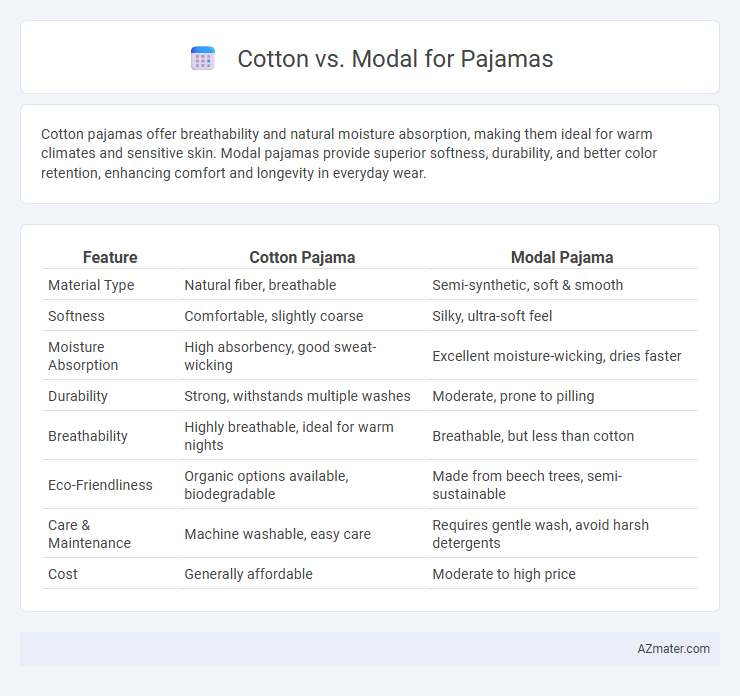Cotton pajamas offer breathability and natural moisture absorption, making them ideal for warm climates and sensitive skin. Modal pajamas provide superior softness, durability, and better color retention, enhancing comfort and longevity in everyday wear.
Table of Comparison
| Feature | Cotton Pajama | Modal Pajama |
|---|---|---|
| Material Type | Natural fiber, breathable | Semi-synthetic, soft & smooth |
| Softness | Comfortable, slightly coarse | Silky, ultra-soft feel |
| Moisture Absorption | High absorbency, good sweat-wicking | Excellent moisture-wicking, dries faster |
| Durability | Strong, withstands multiple washes | Moderate, prone to pilling |
| Breathability | Highly breathable, ideal for warm nights | Breathable, but less than cotton |
| Eco-Friendliness | Organic options available, biodegradable | Made from beech trees, semi-sustainable |
| Care & Maintenance | Machine washable, easy care | Requires gentle wash, avoid harsh detergents |
| Cost | Generally affordable | Moderate to high price |
Introduction to Cotton and Modal Pajamas
Cotton pajamas are valued for their natural breathability, softness, and moisture-wicking properties, making them ideal for comfortable sleep in various climates. Modal pajamas, crafted from beech tree fibers, offer a silky texture, superior drape, and enhanced durability compared to traditional cotton, while maintaining excellent moisture absorption. Both materials provide distinct advantages, with cotton emphasizing natural comfort and modal delivering a luxurious feel and longevity.
What Is Cotton?
Cotton is a natural fiber derived from the seed hairs of the cotton plant, renowned for its breathability, softness, and moisture-wicking properties, making it an ideal fabric choice for pajamas. This textile offers excellent comfort due to its hypoallergenic nature and ability to regulate body temperature, ensuring a restful sleep experience. Cotton's durability and ease of care also contribute to its popularity in sleepwear, maintaining softness and shape after repeated washes.
What Is Modal?
Modal is a type of semi-synthetic fabric made from beech tree cellulose, known for its exceptional softness and breathability, making it a popular choice for pajamas. It absorbs moisture better than cotton, providing a cool and comfortable sleep experience. Unlike traditional cotton, modal maintains its shape and color after many washes, offering durable and luxurious loungewear.
Comfort and Softness Comparison
Modal fabric offers superior softness compared to cotton, making it exceptionally comfortable for pajamas due to its smooth, silky texture that feels gentle against the skin. Cotton is breathable and hypoallergenic but tends to be less smooth, sometimes feeling rougher after multiple washes. Modal excels in moisture-wicking and maintains its softness longer, enhancing comfort during sleep.
Breathability and Moisture-Wicking
Modal fabric outperforms cotton in breathability due to its finer fibers, which allow better airflow and enhanced moisture-wicking capabilities. Cotton absorbs moisture but tends to retain it, leading to a damp and less comfortable feel during sleep, whereas modal effectively draws moisture away from the skin, promoting a dry and cool environment. This makes modal pajamas a superior choice for those seeking enhanced comfort through improved breathability and efficient moisture management.
Durability and Longevity
Modal pajamas offer superior durability compared to cotton due to their resistance to pilling and shrinking, maintaining a smoother texture after multiple washes. Cotton pajamas, while breathable and soft, tend to wear out faster with frequent laundering, showing signs of thinning and fading over time. Choosing modal ensures longer-lasting fabric strength and sustained comfort for pajamas, ideal for extended use.
Environmental Impact and Sustainability
Cotton pajamas generally have a higher environmental impact due to intensive water usage and pesticide application during cultivation, whereas modal fabric, derived from beech tree pulp, offers a more sustainable alternative with lower water consumption and better biodegradability. Modal production involves eco-friendly closed-loop processes that recycle solvents, reducing chemical waste compared to conventional cotton farming. Choosing modal pajamas supports sustainability goals by minimizing resource depletion and promoting eco-conscious textile manufacturing practices.
Skin Sensitivity and Hypoallergenic Properties
Modal fabric, derived from beech tree pulp, offers superior softness and is less likely to cause irritation for individuals with sensitive skin compared to traditional cotton. Cotton, while breathable and naturally hypoallergenic, can sometimes retain allergens or rough fibers that may trigger discomfort in highly sensitive users. Both fabrics are breathable and moisture-wicking, but modal's smoother texture and resistance to shrinkage make it a preferred option for hypoallergenic pajamas.
Care and Maintenance Differences
Cotton pajamas require regular washing in cold or warm water to prevent shrinking and fading, and ironing may be needed to maintain a crisp appearance. Modal pajamas are more resistant to shrinking and fading due to their synthetic fiber blend, requiring gentler washing cycles and avoiding high heat drying to preserve softness and longevity. Modal's moisture-wicking properties reduce odor buildup, making it easier to maintain freshness compared to cotton, which tends to absorb sweat and retain odors longer.
Which Is Best for Your Pajamas?
Modal fabric offers superior softness and moisture-wicking properties compared to cotton, making it ideal for comfortable and breathable pajamas. Cotton, known for its natural breathability and durability, remains a popular choice for those seeking hypoallergenic sleepwear with easy-care benefits. Choosing between cotton and modal depends on whether you prioritize moisture management and silky texture or traditional, durable fabric for your pajamas.

Infographic: Cotton vs Modal for Pajama
 azmater.com
azmater.com